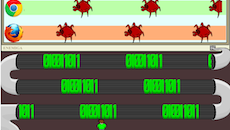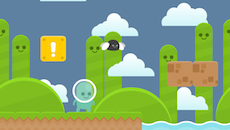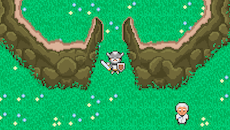

jQuery is a leading multi-browser JavaScript library that developers across the world utilize on a daily basis to help simplify client-side scripting. Using the friendly and powerful jQuery to create games based on DOM manipulations and CSS transforms allows you to target a vast array of browsers and devices without having to worry about individual peculiarities.
jQuery Game Development Essentials will teach you how to use the environment, language, and framework that you're familiar with in an entirely new way so that you can create beautiful and addictive games. With concrete examples and detailed technical explanations you will learn how to apply game development techniques in a highly practical context.
This essential reference explains classic game development techniques like sprite animations, tile-maps, collision detection, and parallax scrolling in a context specific to jQuery. In addition, there is coverage of advanced topics specific to creating games with the popular JavaScript library, such as integration with social networks alongside multiplayer and mobile support. jQuery Game Development Essentials will take you on a journey that will utilize your existing skills as a web developer so that you can create fantastic, addictive games that run right in the browser.
Written as a concise yet practical guide with an explicit focus on utilizing jQuery for game development, you'll learn how to create stunning games that look great - without the hassle of learning about a complex game engine in the process.
All trough the book you will learn by creating three games. You can play them here to give you an idea of what you can expect to achieve once. If you're interessted in the code source you can simple grab it on GitHub.
This is the first game you will make. It's a clone of the classic game Frogger used to demostrate basic techniques such as sprites, animation and preloading as well as some possible optimisation.
The player can jump forward and move sideways with the arrow keys. The player has 3 lifes and the game is over if he looses all of them or reache the top of screen.

This game is a plaformer, it has high-scores, many levels, sound and even integration with Twitter and Facebook. The artwork is by Kenney Vleugels and music by tgfcoder.
The player can move around with the arrow keys. The goal is to finish the level as fast as possible. While you're in the air you travel slower so don't jump to much !.

This top-view isometric RPG. In the book you will learn to create a multi-player game of it but this one is the single player version. The Artwork is from Mozilla's Browser Quest game.
The player can move around with the arrow keys and hit with the spacebar. If you hit an NPC you will speak with it. If you hit an enemy he will try to block you attack. The enemies will not attack you.

Here is a detailed look at the content of each chapter of this book.
This chapter provides an in-depth look at jQuery's functions that might be useful for game development.
In this chapter you will learn to implement a simple game with sprites, animation, and preloading.
Here you will optimizes the game we saw in Chapter 2, Creating Our First Game, with various techniques such as timeout inlining, keyboard polling, and HTML fragments.
You will code a platformer game with tile maps and collision detection.
Learn to create an orthogonal RPG with tile map optimization, sprite occlusion, and better collision detection.
This chapter expands the game we saw in Chapter 4, Looking Sideways, by adding multiple levels using JSON and AJAX.
Here we transform the games we saw in Chapter 5, Putting Things into Perspective, to support multiple players on multiple machines.
Integrate the platform game with Facebook and Twitter as well as creating a cheat-proof leaderboard.
This chapter optimizes the games we saw in Chapter 5, Putting Things into Perspective, for mobile devices and touch control.
Learn to add sound effects or music to your game with the audio element, the Web Audio API, or Flash.
Knowledge of JavaScript and jQuery as well as basic experience with frontend development is all you need to start making games in a matter of hours with this essential guide. Whilst also suitable for those who simply want to start making games with jQuery, it's specifically targeted at web developers that want to experiment with and utilize their existing skills.
Even though a lot of the techniques described in the book apply to vannila Javascript some parts requies basic knowledge of jQuery. But learing jQuery through a simple tutorial and reading throught the first chapter of this book should provide you with all the knowledge you need about jQuery.
This book is not about gameQuery but it answers a lot of the game development questions I encounterd from gameQuery's users during the last years. You won't learn gameQuery but you will create your own framework that has most of the basic functionality of gameQuery. Translating the knowledge you gained from this book to gameQuery should be a walk in the park!
Using jQuery and the DOM to create games may not seam like the most straight forward ways of doing thing but it has several advantages. I think it's a very good way for a beginer to approach game developement since it abstarct all the dirty business of dealing drawing pixels. Furthermore a lot of what you learn in this book will be useable with other rendering techniques such as Canvas or WebGL.
This book was written by Selim Arsever, a Senior Software Engineer working in Switzerland. Over the last 4 years, he has been developing gameQuery, an open source game engine based on jQuery, as well as other JavaScript games and demos.
He has been giving several talks on the subject and thinks that there is nothing more interesting than using tools beyond what they were initially intended for. You can follow him on twitter at @SelimArsever.